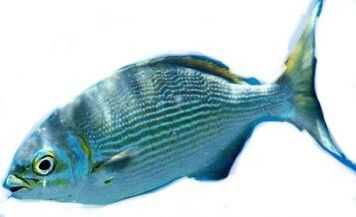Brassy Chub

Species Details
Kyphosus Vaigiensis
Kyphosidae
Perciformes
Onshore, Nearshore, Rocky Bottom, Reef
1 - 3 lbs.
20" - 28"
Brassy Chub (Kyphosus vaigiensis) Description
The Brassy Chub has an oval-shaped and elongated body. Its head is small, with a little mouth, short snout, and sharp teeth. Its body is light silver and so close to white. It has golden and bluish stripes due to its scales that run horizontally across its body. It has a golden streak beneath its eye from the snout to the edge of the eye.
It also has very low anal and dorsal fins. Its anal fins consist of 12 to 14 rays and three spines, while its dorsal fins have 13 to 15 soft rays and up to 11 spines.
Diet & Size
A young and an adult Brassy Chub has different diets. The young ones, which often float among seaweeds, feed on small crustaceans. Adults, however, are carnivorous during autumn and summer. They feed on Endarachne binghamiae, also known as South African Seaweeds, but only during the winter. A Brassy Chub’s typical length is around 19 inches and can grow up to 28 inches. The young ones are barely 2 inches in length.
Interesting Facts
- Brassy Chubs display quite a distinctive color pattern during the spawning season.
- They are most abundant during the starting day of the full month of its spawning season between May and September.
- Brassy Chubs are circumtropical or can be found throughout the tropics.
- A Brassy Chub has teeth on its tongue and the roof of its mouth.
- The Brassy Chub is widely distributed that, according to records, it is found as far as Hauraki Gulf in New Zealand.
Fishing Techniques: How to Catch a Brassy Chub
The best fishing technique to catch a Brassy Chub is handline fishing. You can also charter a boat and go drift fishing, especially when it’s not windy.
Chubs are not difficult to find, even in rivers and lakes. But the key to catching them is your bait. They feed on slugs, small insects, maggots, cut-up shrimps, and even bread crumbs. You can prepare different baits. The secret is to observe which among the baits you have they react positively – going near it, chewing on it, or even biting the hook. Alternatively, you can use tiny artificial lures.
The tricky thing about Brassy Chub is that it is attentive; it can detect if you are fishing for them. You can try and give them pre-bait (like throwing some crumbs into the water). Also, be careful when approaching the water when you’re hand fishing by the lake or the shore.
Habitat and Distribution
The Brassy Chub can be found throughout the tropics and is very widely distributed, typically anywhere with warmer oceans and seas.
It is found from the western coast of the Americas along Panama to Mexico and across the Pacific. It goes as far as Australia and Japan. It is also found in the Indian Ocean through the Red Sea, along the east coast of Africa up to Madagascar.
There’s also a record of Brassy Chubs in the Mediterranean Sea off Sicily, Turkey, Israel, and Cyprus. In the Atlantic Ocean, it is found between the Caribbean, Bermuda, all the to the Ascension Island.
It inhabits mostly around seaward reefs, at the bottom of exposed surf-swept outer reel flats covered in algae and even lagoons. It is found at least 78 feet deep in the ocean. The younger Chubs swim closer to the open ocean's surface while the adult ones swim more proximate to the shore and coastline.







